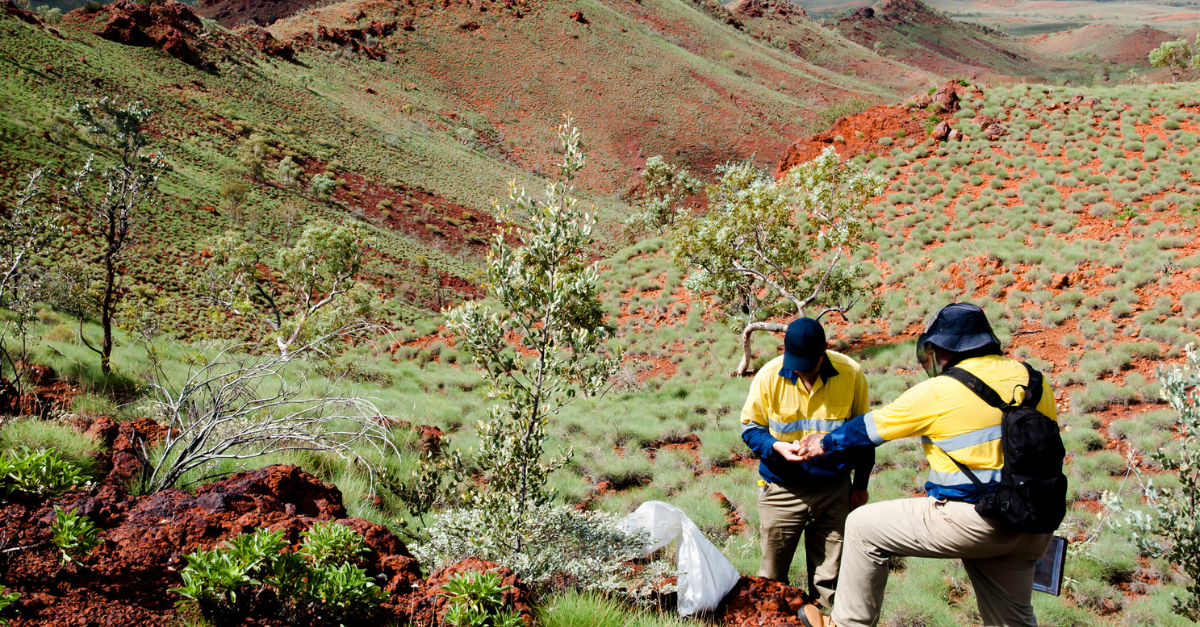The 5 stages of the mining lifecycle are phases that guide the development of a responsible, sustainable mining operation. The lifecycle promotes efficient extraction of mineral resources and protects the health and safety of workers and communities. It drives economic growth and mandates land rehabilitation.
Every new mining project has its requirements and needs a plan to take it from discovery into production. All miners tend to follow the same general process which forms the basis of mine development.
The 5 stages of the mining lifecycle are:
- Exploration & Prospecting
- Planning & Evaluation
- Construction
- Production
- Rehabilitation & Reclamation
1. Exploration & Prospecting
The beginning of any mining project begins with the exploration stage; it’s where the magic happens. Companies enlist geologists and others to understand the characteristics of the land and prospect remote areas in search of mineral deposits. Methods such as geological surface mapping, sampling and geochemical analysis are often applied at an early stage to pin out potential deposits.
At this stage, teams build an understanding of the area of interest, highlighting points of conflict, environmental concerns, sites of significance and regulations about the land. It’s important to ensure key stakeholders are engaged and included in all 5 stages of the mining lifecycle to assist in the identification of impacts, risks and opportunities to the land and surrounding ecosystems. Water, oil and soil are tested and firms start to consider the socio-economic effects that a new mine would have on the area.
This is then followed by prospecting including more detailed surveys that identify possible targets and allow companies to start drilling to find out more about what lies underneath. For example, the sampling work provides a glimpse of the type of ore being mined and the grade it could yield. This allows miners to draw up a very preliminary outline of the potential size of the deposits found using 2D or 3D models of the geological ore.
2. Planning & Evaluation
Once exploration data is collected and the miners are confident that there is an opportunity, the project can move forward to the planning and evaluation stage. This consists of companies evaluating various options with multiple plans that are used to identify the best available one.
Thorough mine planning de-risks projects before major capital outlays and allows miners to design the most efficient and sustainable operations. Key activities include geological analyses, engineering design, metallurgical testing, establishment of social performance metrics, cost modelling, permitting and feasibility studies which provide confidence in the reserve potential and economics while minimising safety and environmental risks. Strong mine planning is crucial for securing financing, optimising capital allocation, maximising resource extraction and ensuring responsible development. It sets the stage for the construction and operational phases that follow.
3. Construction
Once the regulatory, funding and technical aspects of the project are addressed, construction can begin. However, this process can be different depending on the mineral being mined and the size of the project and can often take longer than the exploratory and design stages.
The construction phase transitions a mineral resource into an operational mining facility. It involves extensive site preparation such as clearing, road building and establishing water management systems. Major facilities are then constructed including shafts, pits, processing plants, and supporting infrastructure like housing, offices, and power.
This phase builds the core facilities and systems enabling the mine to begin generating economic value from resource extraction. It sets the stage for the transition to commercial operations.
Engaging stakeholders during construction builds trust, identifies potential issues early and upholds commitments made. It allows the company to manage expectations, reduce opposition, improve impact mitigation and maintain regulatory compliance. Most importantly, it earns the social license and reputation needed for successful long-term operations. Stakeholder inclusion demonstrates the company’s commitment to transparency, accountability and integrity. This proactive community relationship based on mutual understanding and input lays a critical foundation for responsible mining.
4. Production
Two of the most common methods of mining are surface and underground mining. The method is determined by the characteristics of the mineral deposit and limits imposed by safety, environmental and economic concerns. This is the active extraction and processing of the mine’s resources. It involves activities like drilling, excavating, hauling, crushing, grinding, and refining for sale.
5. Rehabilitation & Reclamation
The fifth and final stage is rehabilitation and reclamation. Many mines may be capable of producing economically for decades, but mining is still a temporary activity. Ideally, companies should start preparing for rehabilitation in the early stages of their lifecycle and form their plan for rehabilitation before they begin construction. Governments require assurance that operators have a plan and the funds needed to close the mine before they are willing to issue permits.
The detailed environmental studies that are conducted during the process form a major part of the plan for how the mine site will be rehabilitated.
A comprehensive rehabilitation program has many clearly stated objectives which may include:
- ensuring public health and safety
- minimising environmental effects
- removing waste and hazardous material
- preserving water quality
- stabilising land to protect against erosion
- establishing new landforms and vegetation
Mine rehabilitation plans can aim to renovate the site to varying degrees:
- Remediate the contaminated area, including water.
- Reclamation of the terrain, landscaping and topsoil replacement to make the land useful once again.
- Restore the ecosystem disturbed as a result of the mine.
- Rehabilitate the site to a stable and self-rejuvenating state.
The Value of the Lifecycle
The 5 stages of the mining lifecycle serve a purpose that generates public value. The exploration phase assesses resources and the planning phase determines the best available options for land use. Construction refers to building local infrastructure and facilities and production drives employment and government revenue. Rehabilitation allows you to repatriate the land and ensures long-term environmental protection. The lifecycle informs investment decisions, facilitates project management and ensures stakeholder accountability. A phased lifecycle allows for the regulated, systematic development of resources that balance economic demands with social and environmental responsibilities. Compliance with the mining lifecycle is crucial for the viability of the mining industry.
Stakeholder engagement throughout all project phases demonstrates the company’s commitment to responsibility, transparency and fulfilling obligations. It forges an adaptive partnership that protects corporate reputation and achieves mutually beneficial outcomes for communities and the company and is crucial for earning the social credibility to operate responsibly across the mine’s lifespan.
K2fly offers a suite of solutions designed to support you through all stages – from exploration to rehabilitation. Our land management solutions simplify the approval process required for accessing land and ground disturbance activities whilst considering sites of significance and cultural heritage. Our rehabilitation solution utilised from the exploration phase improves rehabilitation.




